Nếu bạn nào là fan của sashimi, sushi Nhật thì không lạ gì nhà hàng này, nhà hàng này mở ở Sài Gòn cũng được mấy năm rồi. Trước khi nhà hàng này khai trương, tụi mình thường ghé Hokkaido Sachi hoặc Tei. Sau này thì thường ghé bên đây hoặc Tei hơn. Sau những ngày Tết ngập trong thịt thì ăn sashimi như vậy thiệt giải ngán, đổi khẩu vị (đối với mình là như vậy).
Năm nay, Chiyoda bán từ mùng 2, còn Tei thì bán xuyên Tết. Nếu đi Tei mấy ngày Tết thì có tính thêm tiền phí phục vụ lễ, Tết, không cho book bàn, bên CN Đông Du đỡ hơn, bên Lý Tự Trọng thường tụi mình phải xếp hàng chờ ah.
Địa chỉ:
178 Pasteur, P. Bến Nghé, Quận 1, TP. HCM
Sau đây là 1 vài đánh giá của tụi mình:
Không gian: quán có không gian trệt và trên lầu, phía dưới trệt mình thấy cũng bình thường à. Mình thích ngồi trệt, thò chân xuống như kiểu trên lầu này hơn. Trên lầu có phòng riêng, thường muốn ngồi mấy phòng này bạn phải book trước với nhân viên. Trang trí nhìn đẹp, ấm cúng, có cây có nước mà cây giả nên hơi chán. Trên bàn có chuông bấm để gọi nhân viên.
Phục vụ:
Nhân viên khá niềm nở, trên lầu có vẻ lượng nhân viên bố trí hơi ít nên thấy mấy bạn xoay mòng mòng luôn. Món ăn lên nhanh và liên tục. Vì ít nhân viên và đông khách nên có làm sai món nước (điểm trừ).
Thực đơn:
Mình thấy cả bên đây và Tei menu đều rất nhiều loại cá, nhiều món ngoài sashimi, sushi còn có cơm, bò, mì… Bên đây hay có mấy loại được nhập trực tiếp từ chợ cá Toyosu (trước đây là nhập từ chợ cá Tsukiji – Tokyo, hiện tại chợ này đã bị đóng) nên tụi mình thích. Khuyết điểm là thường không có cá chày/ gan cá chày (ankimo) như bên Tei và menu món tráng miệng không được ngon và nhiều như bên Tei.
Thức uống:
Khá nhiều loại từ cocktail, mocktail, highball… Bạn gấu nhà mình thích highball nên có gọi thử loại Highball trà xanh, cuối cùng loại này lại không ngon, mấy loại highball trái cây (loại chua chua) có vẻ ngon hơn.
- Ly highball trà xanh và ly trà xanh nhìn sơ qua y hệt luôn đó :))), khác cái là trà xanh đựng trong ly thấp hơn, suông đuột, còn ly highball trà xanh đựng trong ly cao hơn, có uốn lượn.
- Acelora theo như nhân viên nói là nước ép sơ-ri tươi, mình có kêu uống thử nhưng nó kiểu lạt lạt, không ngon, vị cũng không rõ sơ-ri đâu.
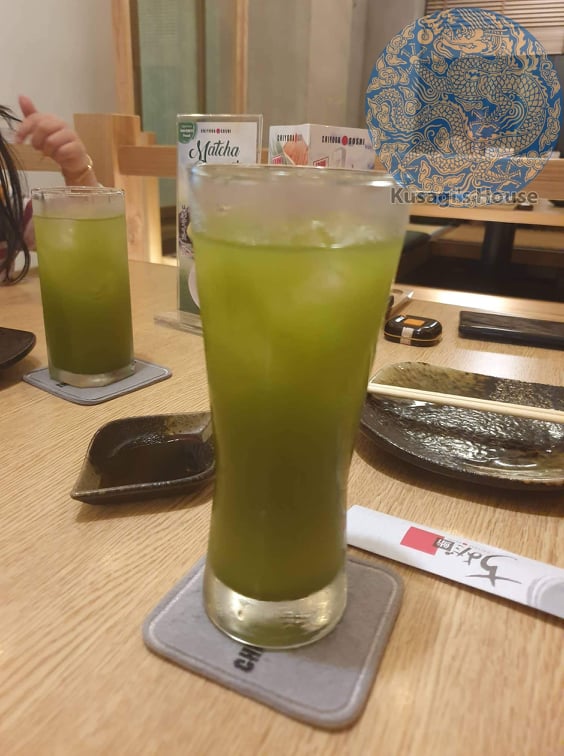
Ryokucha Highball – 68k 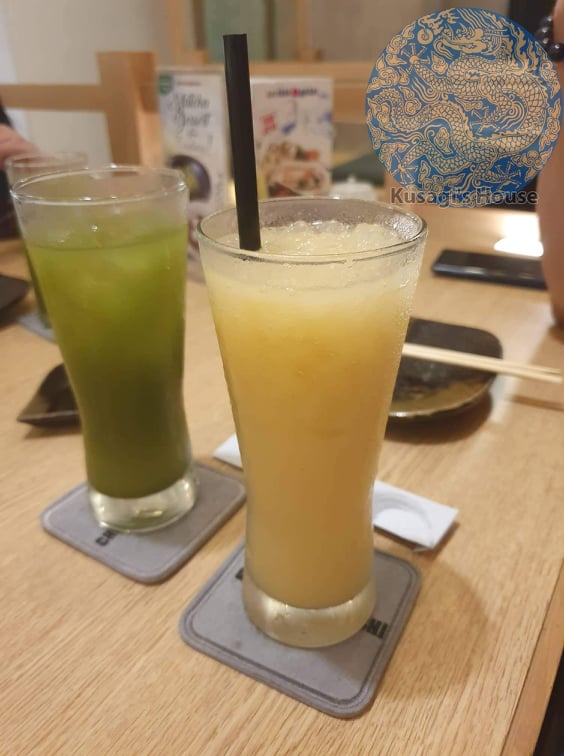
Acerola – 45k
Món ăn:
California Salmon Roll: loại này hầu như nhà hàng sushi nào cũng có, một phần 8 miếng, miếng vừa phải, đơn giản, trứng cá ngon.
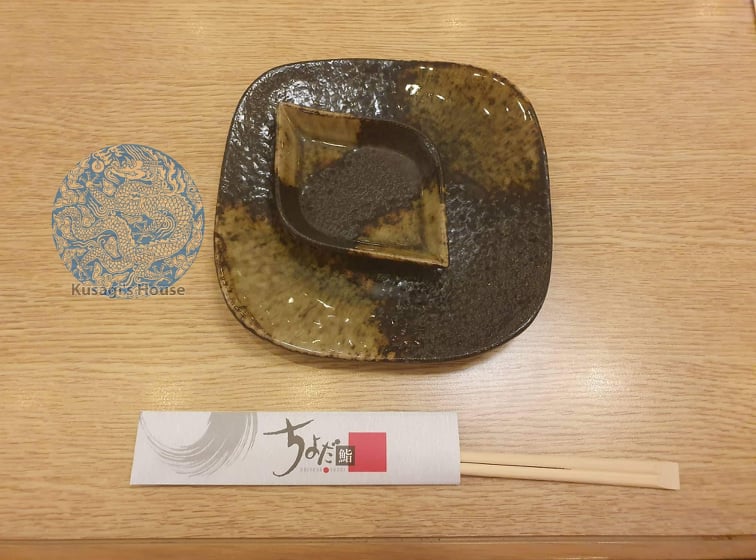
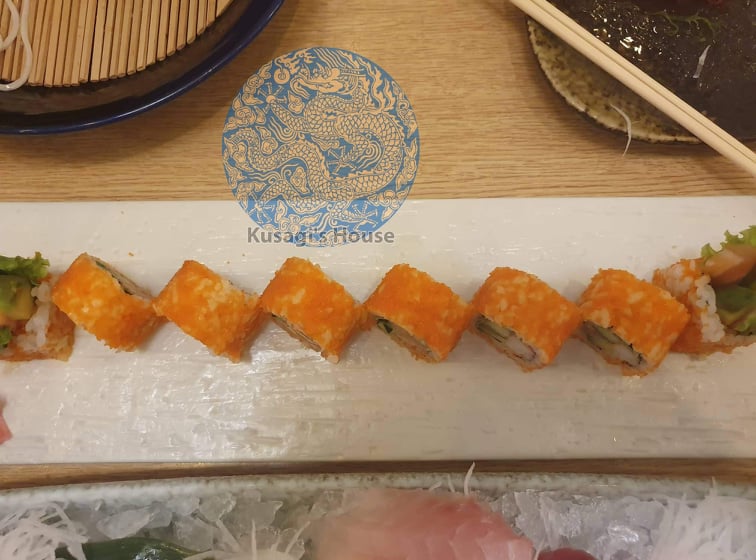
California Salmon Roll – 135k
Tụi mình thấy set sushi mỗi loại có 1 cái khó chia, và các loại khá thông dụng nên không gọi. Tụi mình gọi lẻ theo ý thích ha. Đây là set của 2 loại sushi mà tụi mình kêu, nhân viên bỏ chung luôn:
- Uni Gunkan (sushi nhím biển): tươi, ngọt, béo béo nhẹ, ăn như tan vô miệng.
- Ama Ebi Nigiri (sushi tôm ngọt): loại tôm ngọt nhỏ thôi, thịt tôm ngọt ngay à, hơi mềm, nếu muốn ngon nữa chắc phải vô mấy chỗ kaiseki ah. Mình đánh giá ở đây có món này là cũng tốt và khá ngon rồi, ăn đã thèm.
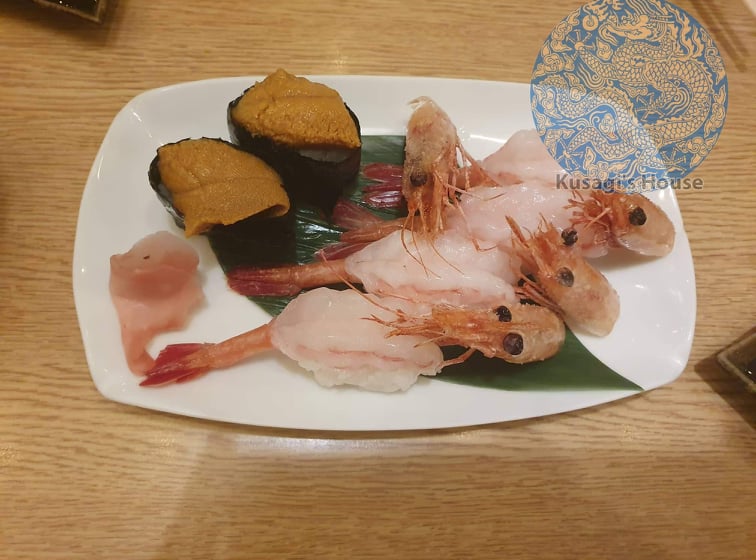
Sashimi tụi mình không gọi mấy thuyền như đợt trước mà gọi theo từng set nhỏ, cuối cùng nhân viên vẫn gom lại các phần sashimi và bỏ vào 1 dĩa lớn dài. Hơi không vui vì biết là bỏ vậy tiện và tiết kiệm diện tích nhưng khó kiểm soát món, bản thân nhân viên phục vụ còn hơi bị mù mờ giữa các set trong dĩa này luôn. Tụi mình coi lại hình trong menu check lại thì thấy ok, đúng các phần cần gọi:
- Salmon Sashimi Moriawase (set sashimi cá hồi): gồm thịt cá và bụng cá hồi, tươi, béo, ngon, miếng dài và dày vừa phải.
- Maguro Sashimi Moriawase (set sashimi cá ngừ): mặc dù sashimi cá hồi phổ biến, nhưng ở Nhật họ không chuộng và không đánh giá cao cá hồi, họ thích cá ngừ hơn. Bạn thấy giá set này nhỉnh hơn phần cá hồi rất nhiều, nhỉnh hơn cả set tổng hợp bên dưới luôn nha. Phần cá ngừ này có thịt, bụng và thịt băm. Phần mình thích nhất của set này là bụng cá ngừ, tươi, béo thiệt béo ăn đã. Thịt băm ăn béo béo, bình thường.
- Meibutsu Tokusen Sashimi Moriawase (set tổng hợp có cá hồng, cá hồi, cá ngừ, sò điệp và cồi sò điệp): cá hồng ăn cũng khá ngon đó, sò điệp tươi, ngọt, cồi dai dai.
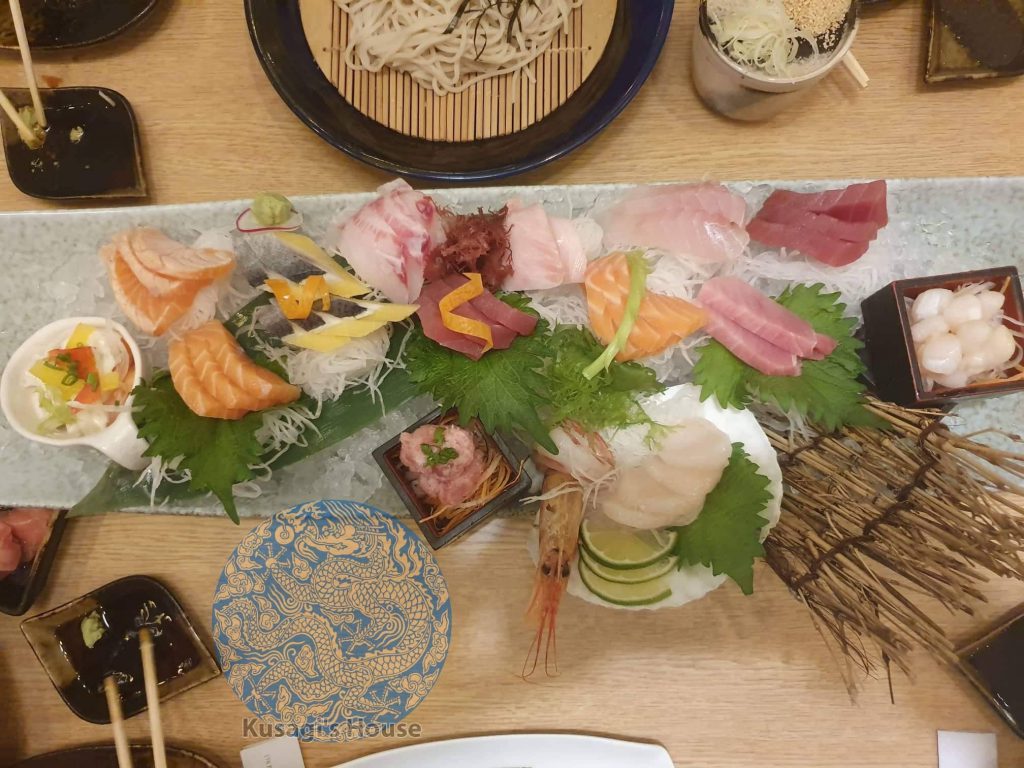
Mình thích loại salad wakame này ở mấy nhà hàng sushi nên lần nào đi cũng gọi, ăn dai dai, mặn ngọt, đậm đà, mát mát. Phần cơm cá hồi bơ khá là nhiều, do khúc cuối chưa no lắm nên tụi mình gọi thêm cơm, cơm dẻo, chan thêm chút nước tương là ăn vừa miệng, có trứng cá hồi bự, mặn mặn cắn bụp bụp khá đã miệng.
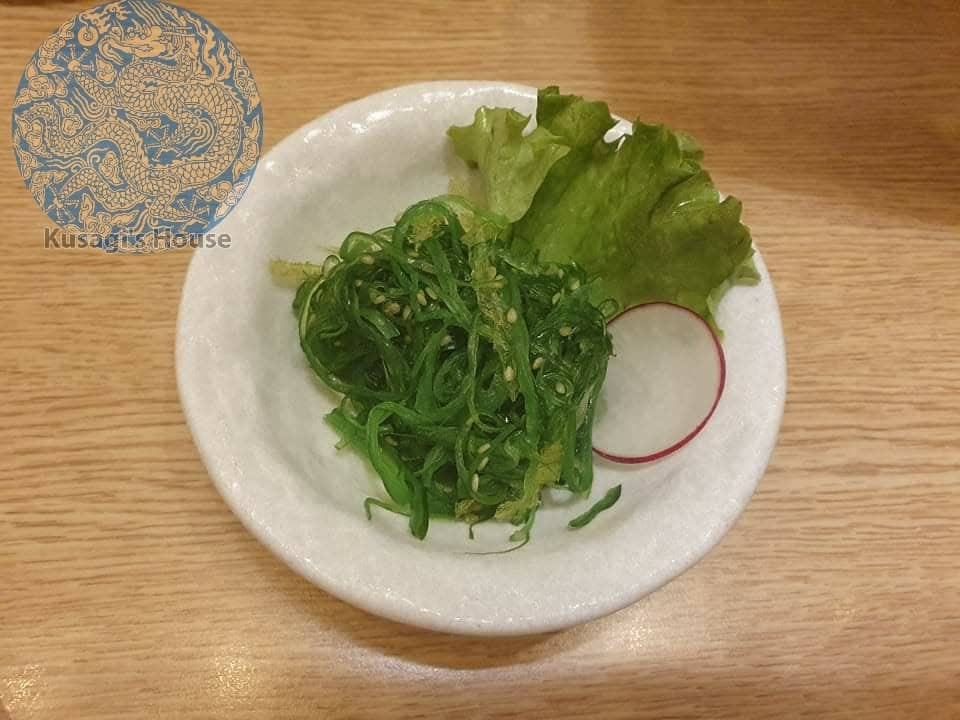
Chyuka Wakame – 55k 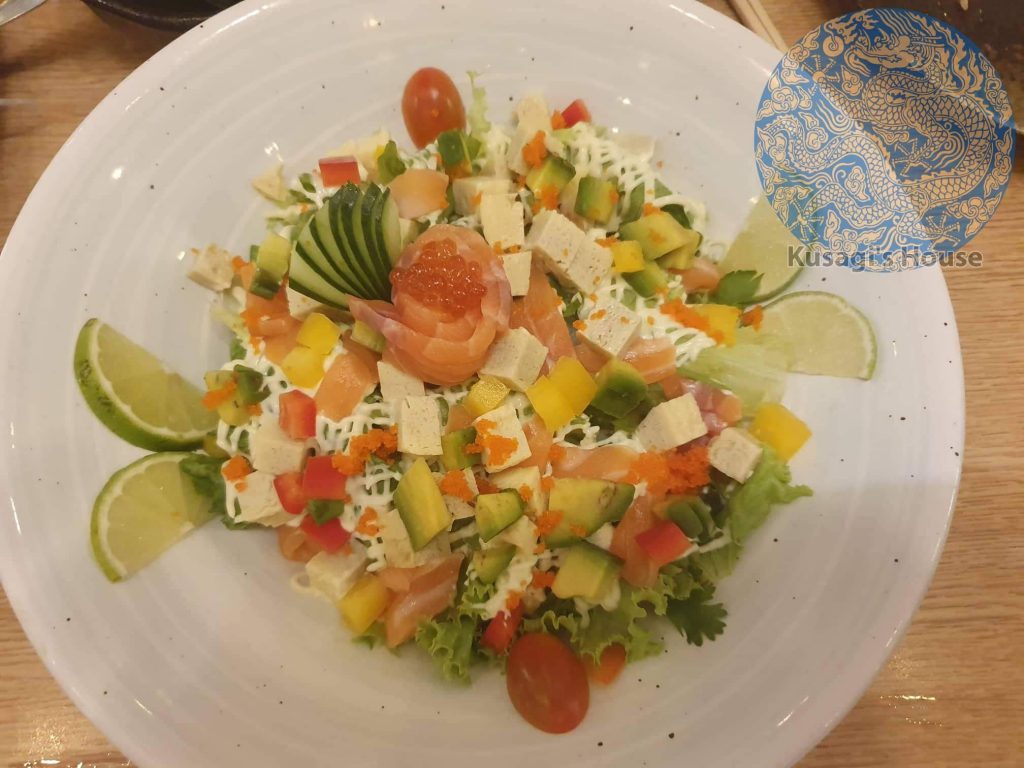
Salmon Avocado Chirashi – 155k
- Zaru soba (mì soba lạnh): món này thanh mát, mì được ướp lạnh, sợi dai, nước chấm pha mặn mặn, ngọt ngọt, bỏ thêm mè cho béo và wasabi tăng vị hăng. Chấm mì ăn vừa miệng, nước này húp không vẫn thấy ngon.
- Engawa Carpaccio Sashimi (cá bơn): cá bơn sống trộn sốt Mayonnaise và hành tây sống ăn mát, nuột, béo, ngon.
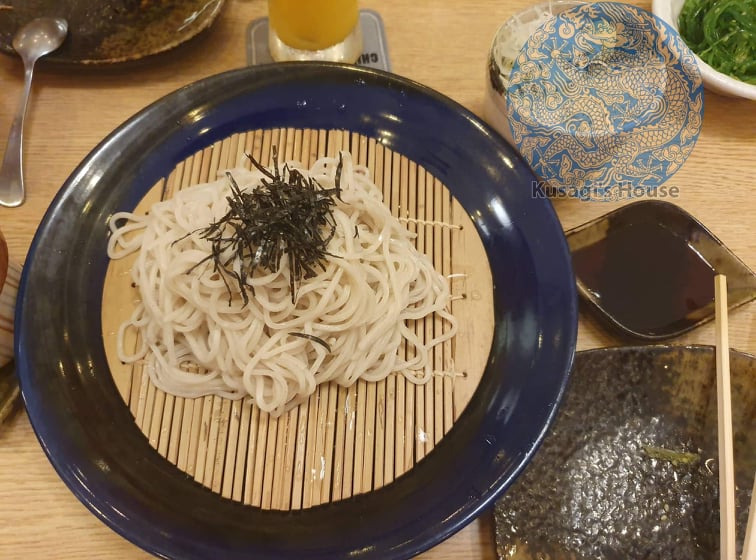
Zaru Soba – 95k 
Engawa Carpaccio Sashimi – 168k
Bạn mình thích sushi loại có rong biển cuốn nên tụi mình gọi thêm set Chiyoda này. Set này lấy theo tên nhà hàng, kiểu nhà hàng tự chế, giống bỏ tả pí lù các loại vô 1 cuộn rong biển: ớt chuông, cà rốt, cá ngừ, trứng, bơ… Một cuốn dày, to (chụp từ trên xuống và chụp ngang để thấy độ khủng của nó). Lần đầu ăn set này thấy ngon lắm, giờ thấy cũng bình thường, bạn nào chưa ăn có thể thử, cảm giác lần đầu sẽ không tệ.
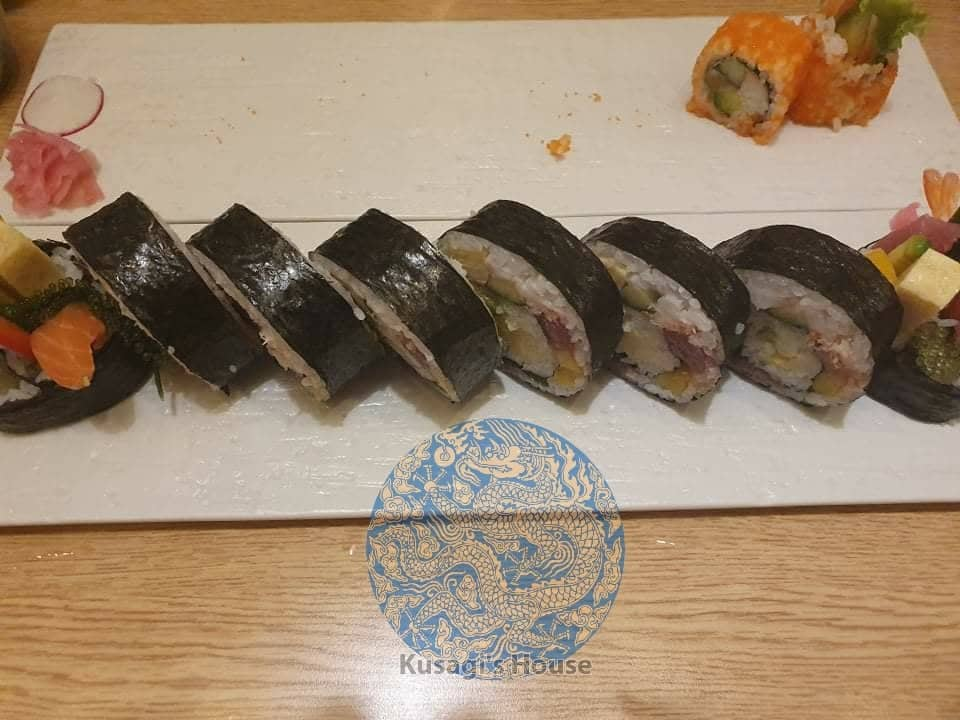
Chiyoda Roll – 185k 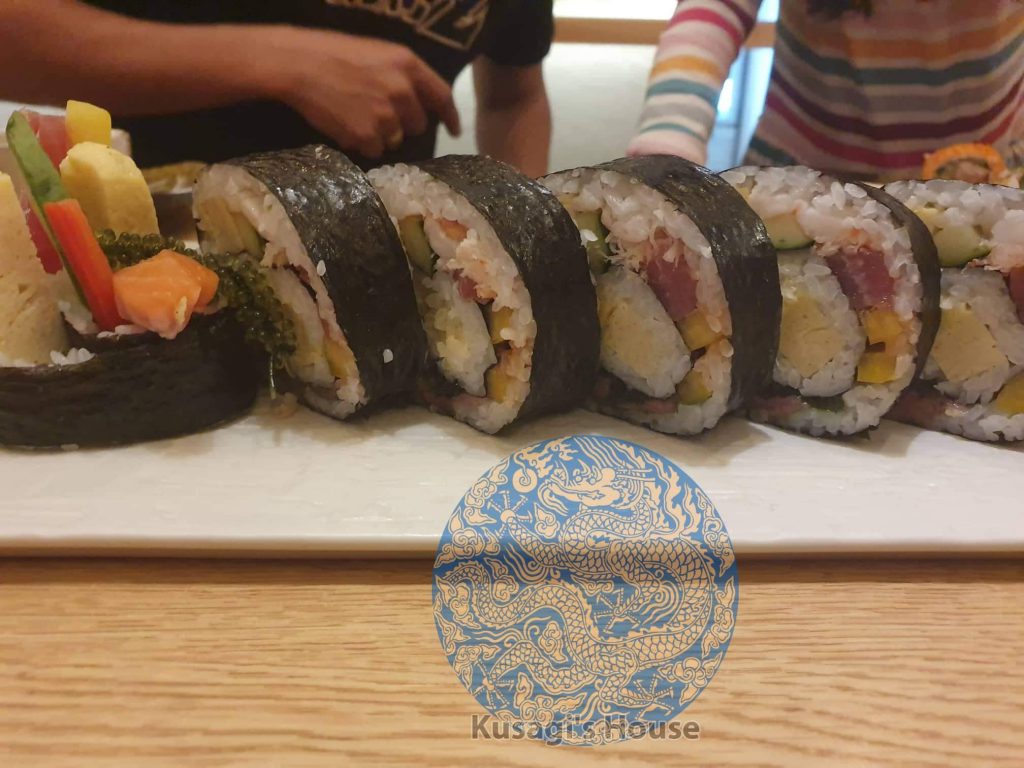
Chiyoda Roll – 185k
Giá cả: hơi bị cao, nhưng đồ ăn tươi, lát cá cắt chất lượng, đáng tiền. Thiệt hại: ~2tr990k/ 4 người. Giá trên hình chưa bao gồm 10% VAT. Mình có làm thẻ thành viên nên được giảm 5%, đi ăn mùng 6 Tết không thấy charge thêm phí gì, không chắc mùng 2, mùng 3 có bị charge thêm phí không.
Cảm ơn các bạn đã đọc bài viết. Hẹn gặp các bạn ở bài review tiếp theo.
Usagi

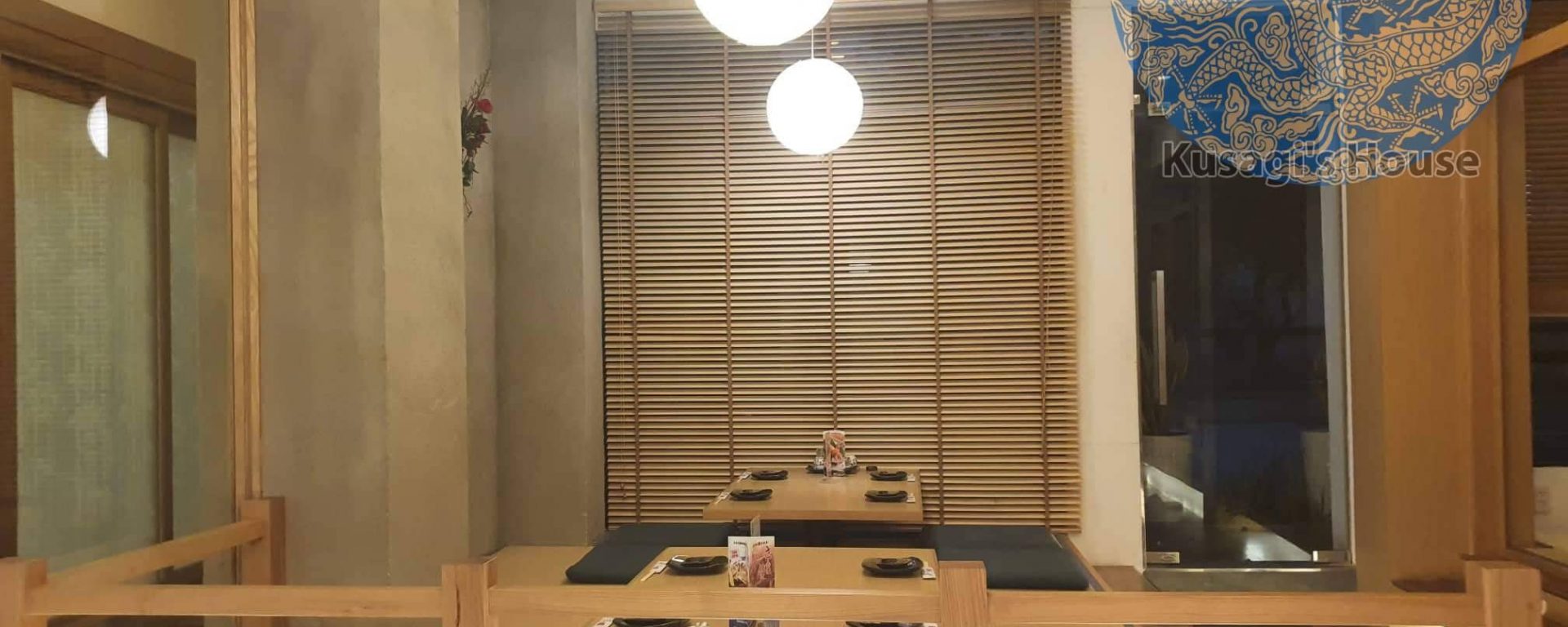
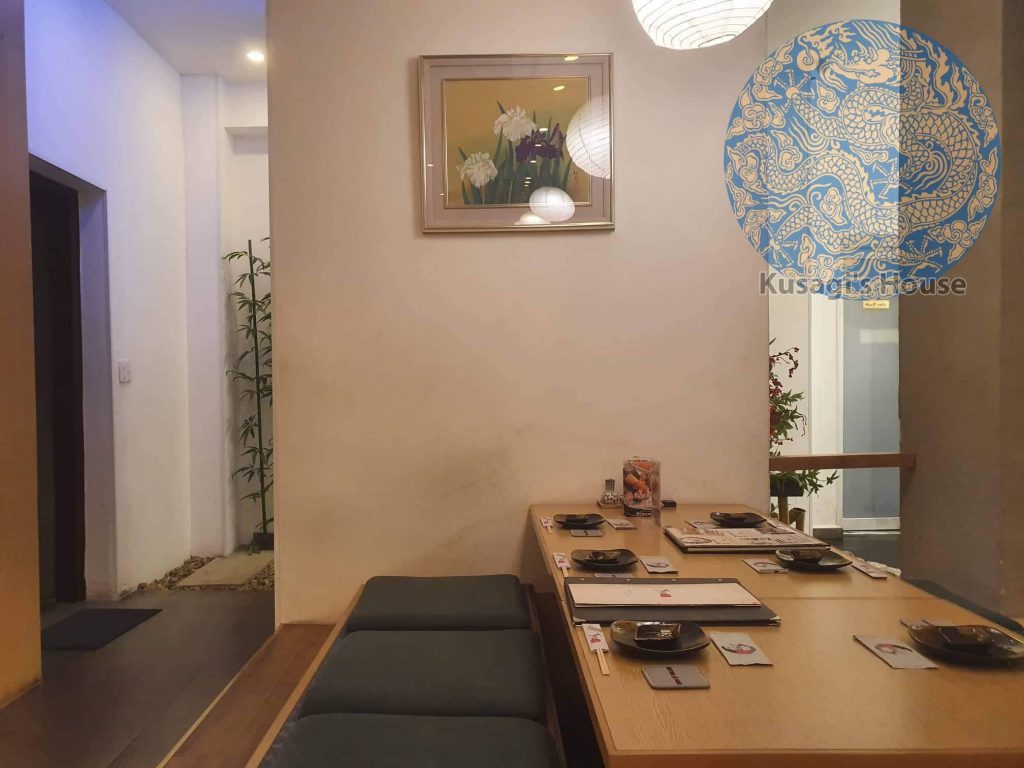
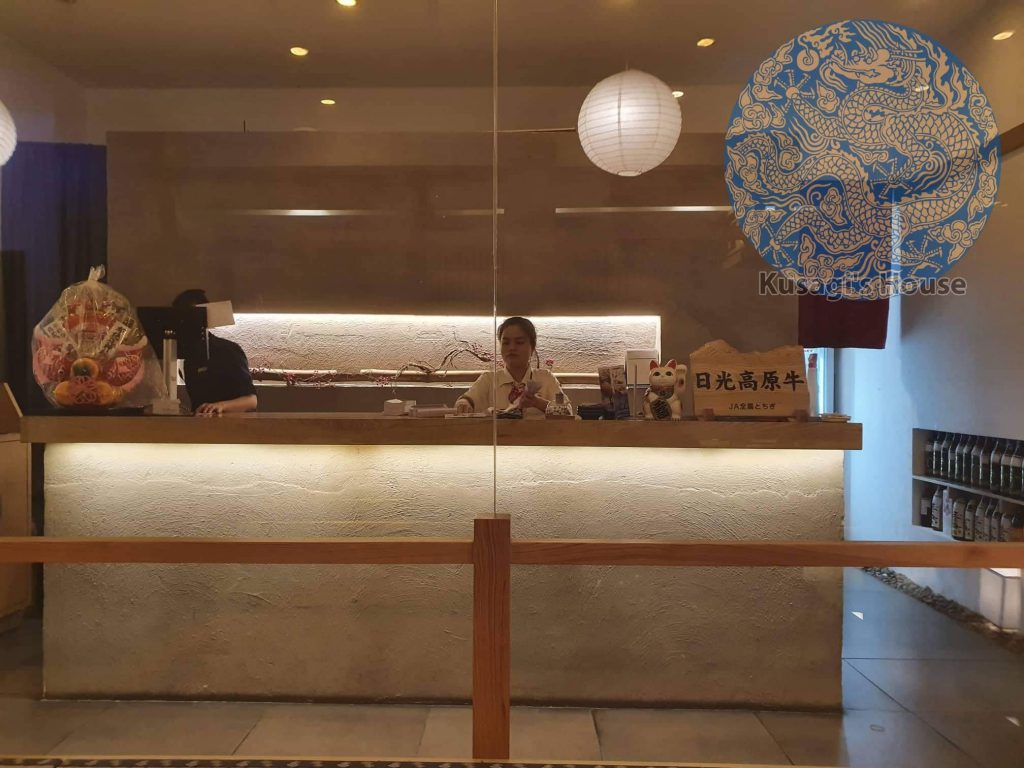
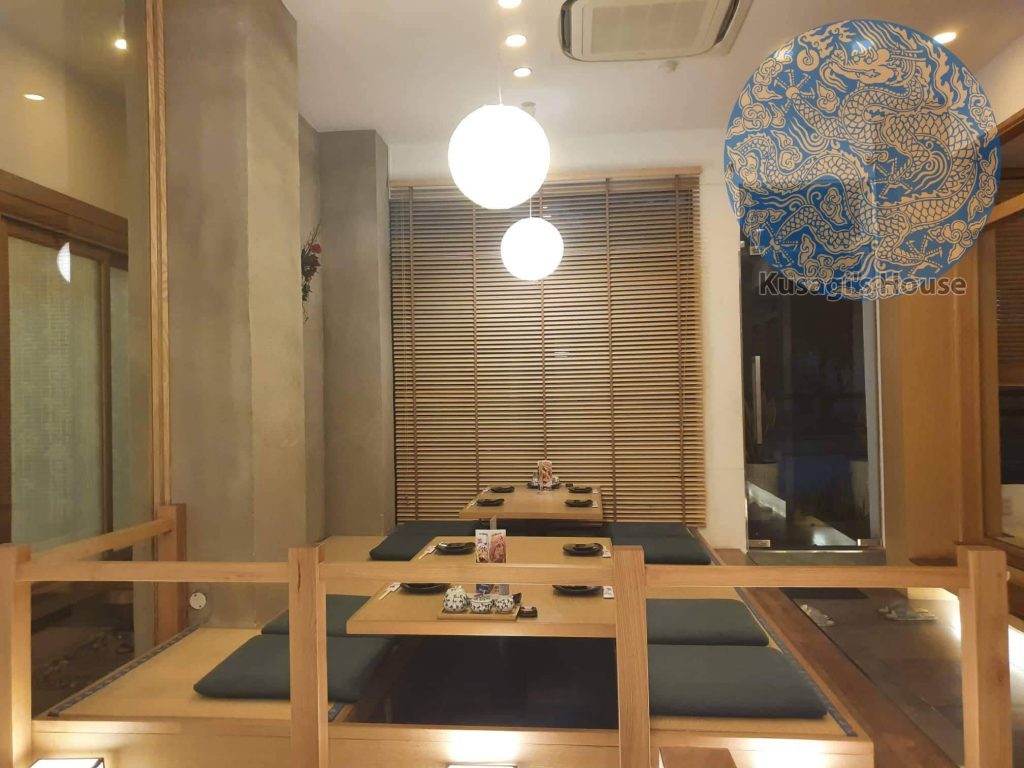
http://mtupartnerid.quadri.com/__media__/js/netsoltrademark.php?d=https://t.me/Vodka_slots/1088
look what i found https://agentsland.cc
вавада зеркало: вавада зеркало – vavada casino
Continue https://exponent.lat/
Water and life
Eth Mixer
Lightning is a dramatic display of electrical power, but it is also sporadic and unpredictable. Even on a volatile Earth billions of years ago, lightning may have been too infrequent to produce amino acids in quantities sufficient for life — a fact that has cast doubt on such theories in the past, Zare said.
Water spray, however, would have been more common than lightning. A more likely scenario is that mist-generated microlightning constantly zapped amino acids into existence from pools and puddles, where the molecules could accumulate and form more complex molecules, eventually leading to the evolution of life.
“Microdischarges between obviously charged water microdroplets make all the organic molecules observed previously in the Miller-Urey experiment,” Zare said. “We propose that this is a new mechanism for the prebiotic synthesis of molecules that constitute the building blocks of life.”
However, even with the new findings about microlightning, questions remain about life’s origins, he added. While some scientists support the notion of electrically charged beginnings for life’s earliest building blocks, an alternative abiogenesis hypothesis proposes that Earth’s first amino acids were cooked up around hydrothermal vents on the seafloor, produced by a combination of seawater, hydrogen-rich fluids and extreme pressure.
Yet another hypothesis suggests that organic molecules didn’t originate on Earth at all. Rather, they formed in space and were carried here by comets or fragments of asteroids, a process known as panspermia.
“We still don’t know the answer to this question,” Zare said. “But I think we’re closer to understanding something more about what could have happened.”
Though the details of life’s origins on Earth may never be fully explained, “this study provides another avenue for the formation of molecules crucial to the origin of life,” Williams said. “Water is a ubiquitous aspect of our world, giving rise to the moniker ‘Blue Marble’ to describe the Earth from space. Perhaps the falling of water, the most crucial element that sustains us, also played a greater role in the origin of life on Earth than we previously recognized.”
https://maps.google.lu/url?sa=t&url=https://t.me/VAVADA_OFFICIAL_SLOTS/2072
go right here https://aixbt.my/
http://ecochristians.org/__media__/js/netsoltrademark.php?d=https://t.me/Vodka_slots/943
http://maps.google.com.hk/url?q=https://t.me/VAVADA_OFFICIAL_SLOTS/1463
Click This Link https://elara.cc
Water and life
Ethereum Mixer
Lightning is a dramatic display of electrical power, but it is also sporadic and unpredictable. Even on a volatile Earth billions of years ago, lightning may have been too infrequent to produce amino acids in quantities sufficient for life — a fact that has cast doubt on such theories in the past, Zare said.
Water spray, however, would have been more common than lightning. A more likely scenario is that mist-generated microlightning constantly zapped amino acids into existence from pools and puddles, where the molecules could accumulate and form more complex molecules, eventually leading to the evolution of life.
“Microdischarges between obviously charged water microdroplets make all the organic molecules observed previously in the Miller-Urey experiment,” Zare said. “We propose that this is a new mechanism for the prebiotic synthesis of molecules that constitute the building blocks of life.”
However, even with the new findings about microlightning, questions remain about life’s origins, he added. While some scientists support the notion of electrically charged beginnings for life’s earliest building blocks, an alternative abiogenesis hypothesis proposes that Earth’s first amino acids were cooked up around hydrothermal vents on the seafloor, produced by a combination of seawater, hydrogen-rich fluids and extreme pressure.
Yet another hypothesis suggests that organic molecules didn’t originate on Earth at all. Rather, they formed in space and were carried here by comets or fragments of asteroids, a process known as panspermia.
“We still don’t know the answer to this question,” Zare said. “But I think we’re closer to understanding something more about what could have happened.”
Though the details of life’s origins on Earth may never be fully explained, “this study provides another avenue for the formation of molecules crucial to the origin of life,” Williams said. “Water is a ubiquitous aspect of our world, giving rise to the moniker ‘Blue Marble’ to describe the Earth from space. Perhaps the falling of water, the most crucial element that sustains us, also played a greater role in the origin of life on Earth than we previously recognized.”
additional info https://alchemistai.cc/
Purchase Ready-Made Accounts Ready-Made Accounts for Sale
go now https://nucleusearn.xyz/
visit homepage https://hyperdrive.my/
I just couldn’t leave your website before suggesting that I really enjoyed the usual information an individual supply on your visitors? Is gonna be back often in order to investigate cross-check new posts
pin up az pin up pinup az
More hints https://nucleusearn.xyz/
Water and life
Ethereum Mixer
Lightning is a dramatic display of electrical power, but it is also sporadic and unpredictable. Even on a volatile Earth billions of years ago, lightning may have been too infrequent to produce amino acids in quantities sufficient for life — a fact that has cast doubt on such theories in the past, Zare said.
Water spray, however, would have been more common than lightning. A more likely scenario is that mist-generated microlightning constantly zapped amino acids into existence from pools and puddles, where the molecules could accumulate and form more complex molecules, eventually leading to the evolution of life.
“Microdischarges between obviously charged water microdroplets make all the organic molecules observed previously in the Miller-Urey experiment,” Zare said. “We propose that this is a new mechanism for the prebiotic synthesis of molecules that constitute the building blocks of life.”
However, even with the new findings about microlightning, questions remain about life’s origins, he added. While some scientists support the notion of electrically charged beginnings for life’s earliest building blocks, an alternative abiogenesis hypothesis proposes that Earth’s first amino acids were cooked up around hydrothermal vents on the seafloor, produced by a combination of seawater, hydrogen-rich fluids and extreme pressure.
Yet another hypothesis suggests that organic molecules didn’t originate on Earth at all. Rather, they formed in space and were carried here by comets or fragments of asteroids, a process known as panspermia.
“We still don’t know the answer to this question,” Zare said. “But I think we’re closer to understanding something more about what could have happened.”
Though the details of life’s origins on Earth may never be fully explained, “this study provides another avenue for the formation of molecules crucial to the origin of life,” Williams said. “Water is a ubiquitous aspect of our world, giving rise to the moniker ‘Blue Marble’ to describe the Earth from space. Perhaps the falling of water, the most crucial element that sustains us, also played a greater role in the origin of life on Earth than we previously recognized.”
Профессиональный сервисный центр по ремонту Apple iPhone в Москве.
Мы предлагаем: ремонт iphone вызвать мастера
Наши мастера оперативно устранят неисправности вашего устройства в сервисе или с выездом на дом!